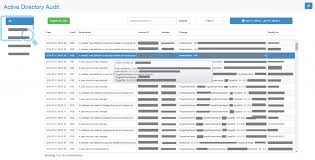The Power of PowerShell in Active Directory Auditing
Active Directory (AD) is the heart of many organisations’ IT infrastructure, managing user accounts, permissions, and access to resources. Ensuring the security and compliance of your AD environment is crucial in today’s threat landscape. One powerful tool that can aid in this endeavour is PowerShell.
What is PowerShell?
PowerShell is a command-line shell and scripting language developed by Microsoft for task automation and configuration management. It provides IT professionals with a robust framework to manage Windows environments efficiently.
Why Use PowerShell for AD Audit?
When it comes to auditing Active Directory, PowerShell offers significant advantages:
- Automation: PowerShell allows you to automate repetitive tasks involved in AD auditing, saving time and reducing human error.
- Customisation: You can create custom scripts tailored to your organisation’s specific audit requirements, enabling detailed monitoring and reporting.
- Real-time Monitoring: PowerShell scripts can be scheduled to run at regular intervals, providing real-time insights into changes and activities within AD.
- Data Analysis: PowerShell’s data processing capabilities allow you to analyse audit logs, track user behaviour, and detect anomalies that may indicate security threats.
- Compliance: By leveraging PowerShell scripts for AD audit, you can ensure compliance with industry regulations and internal security policies more effectively.
Common Use Cases for PowerShell AD Audit
Some common scenarios where PowerShell can enhance your Active Directory auditing practices include:
- Detecting changes to user permissions or group memberships
- Monitoring login activities and failed login attempts
- Auditing password policy compliance
- Tracking changes to Group Policy Objects (GPOs)
- Identifying inactive user accounts for cleanup
In Conclusion
Incorporating PowerShell into your Active Directory auditing strategy can elevate the security posture of your organisation by providing granular visibility into AD activities and configurations. By harnessing the power of scripting and automation, you can proactively identify potential threats, streamline compliance efforts, and strengthen overall IT governance.
6 Essential Tips for Effective PowerShell AD Auditing and Security Management
- Enable auditing in Active Directory to track changes and monitor activities.
- Regularly review audit logs to detect any suspicious or unauthorized activities.
- Use PowerShell scripts to automate the auditing process and generate reports.
- Implement least privilege access to restrict unnecessary permissions for users.
- Ensure proper training for IT staff on PowerShell AD auditing best practices.
- Keep software and systems up to date to prevent vulnerabilities that could be exploited.
Enable auditing in Active Directory to track changes and monitor activities.
Enabling auditing in Active Directory is a crucial step to enhance security and maintain visibility into user actions and system modifications. By activating auditing features, organisations can track changes, monitor activities, and generate detailed logs that capture critical events within the AD environment. This proactive approach not only helps in identifying suspicious behaviour and potential security breaches but also aids in compliance with regulatory requirements by providing a comprehensive audit trail of user interactions and system events.
Regularly review audit logs to detect any suspicious or unauthorized activities.
Regularly reviewing audit logs is a crucial tip in PowerShell Active Directory auditing. By consistently monitoring these logs, organisations can promptly detect any suspicious or unauthorised activities within their AD environment. This proactive approach enables IT teams to identify potential security threats, such as unauthorised access attempts or unusual user behaviour, and take immediate action to mitigate risks and safeguard the integrity of their Active Directory infrastructure.
Use PowerShell scripts to automate the auditing process and generate reports.
By utilising PowerShell scripts to automate the auditing process in Active Directory, organisations can streamline their security efforts and enhance efficiency. These scripts can be tailored to monitor specific activities within AD, such as user permissions changes or login attempts, and generate detailed reports automatically. This automation not only saves time but also ensures that audits are conducted consistently and accurately, providing valuable insights into the integrity of the AD environment.
Implement least privilege access to restrict unnecessary permissions for users.
Implementing the principle of least privilege access is a crucial tip when utilising PowerShell for Active Directory auditing. By restricting users to only the permissions necessary for their roles, organisations can minimise the risk of unauthorised access and potential security breaches. This practice ensures that users have the minimum level of access required to perform their tasks effectively, enhancing overall security posture and reducing the likelihood of malicious activities within the AD environment.
Ensure proper training for IT staff on PowerShell AD auditing best practices.
To maximise the effectiveness of PowerShell for Active Directory auditing, it is essential to provide comprehensive training to IT staff on best practices. Ensuring that your team is well-versed in PowerShell scripting, AD auditing techniques, and security protocols will not only enhance their skills but also empower them to utilise PowerShell effectively for monitoring and securing the AD environment. Proper training equips IT staff with the knowledge and expertise needed to create custom scripts, interpret audit data accurately, and respond promptly to potential security incidents, ultimately strengthening the overall cybersecurity posture of the organisation.
Keep software and systems up to date to prevent vulnerabilities that could be exploited.
Ensuring that your software and systems are regularly updated is crucial when utilising PowerShell for Active Directory auditing. By keeping everything up to date, you reduce the risk of vulnerabilities that malicious actors could exploit to compromise your AD environment. Regular updates not only patch known security flaws but also enhance the overall stability and performance of your systems, enabling a more robust defence against potential cyber threats. Stay proactive in maintaining the security of your IT infrastructure by prioritising software and system updates as part of your AD audit strategy.

